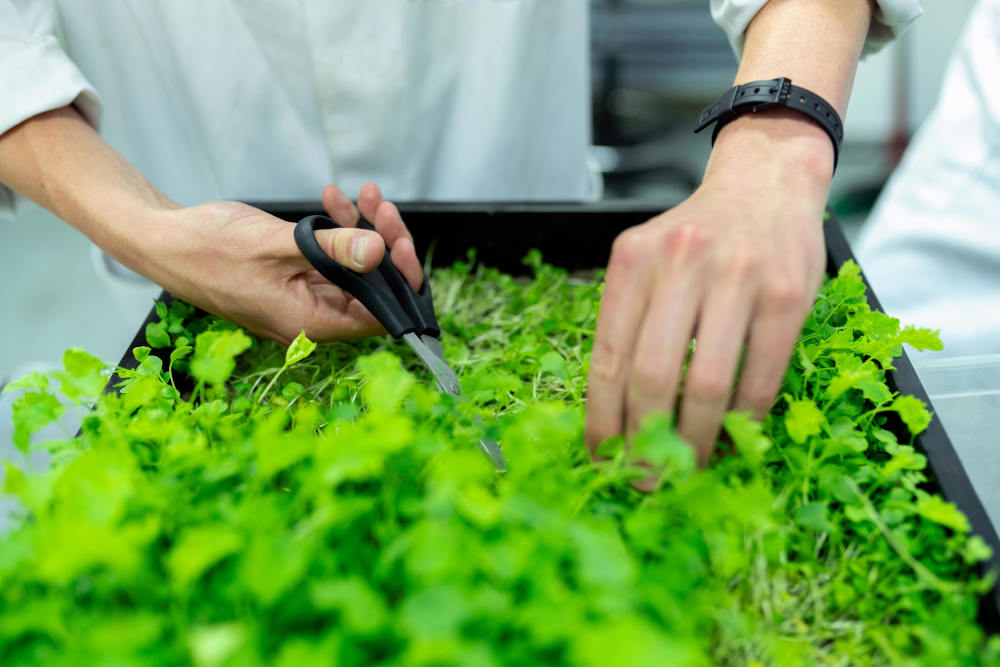
Cultiver des herbes aromatiques à partir de graines est une façon abordable et enrichissante de démarrer son propre jardin. Mais dans la zone de rusticité USDA 5 , où les hivers sont longs et les gelées persistantes jusqu'au printemps, le choix du moment est primordial . Semer des graines d'herbes aromatiques en intérieur vous donne une longueur d'avance sur la saison de croissance, mais savoir exactement quand commencer est la clé du succès.
Dans cet article, nous expliquerons quand et comment démarrer des graines d'herbes populaires à l'intérieur dans la zone 5, en tenant compte de la date moyenne du dernier gel, des temps de germination de chaque herbe et des meilleures pratiques pour des transplantations saines.
Panaprium est indépendant et pris en charge par les lecteurs. Si vous achetez quelque chose via notre lien, nous pouvons gagner une commission. Si vous le pouvez, veuillez nous soutenir sur une base mensuelle. La mise en place prend moins d'une minute et vous aurez un impact important chaque mois. Merci!
Comprendre le climat de la zone 5
La zone 5 comprend des parties du Midwest, du Nord-Est et des régions montagneuses des États-Unis. Elle est définie par des températures hivernales minimales moyennes comprises entre -29 °C et -23 °C (-20 °F et -10 °F).
En zone 5, la date moyenne du dernier gel se situe généralement entre le 15 avril et le 15 mai . Cette date est importante, car la plupart des herbes sont sensibles au gel et doivent être transplantées une fois le risque de gel passé .
Pourquoi cultiver des herbes aromatiques à l’intérieur ?
Les herbes ont généralement une croissance lente et les démarrer à l'intérieur offre plusieurs avantages dans la zone 5 :
-
Prolonge la saison de croissance
-
Fournit des conditions contrôlées pour une meilleure germination
-
Réduit le risque de dommages causés par le gel
-
Donne aux semis un bon départ avant de les transplanter à l'extérieur
Certaines herbes, comme le basilic et le romarin, sont particulièrement sensibles au froid et bénéficient grandement d’un démarrage en intérieur.
Facteurs clés qui déterminent l'heure de début
Avant de prendre vos sachets de graines, tenez compte de ces facteurs :
-
Temps de germination – Le temps qu’il faut aux graines pour germer.
-
Taux de croissance – La vitesse à laquelle les semis atteignent la taille de transplantation.
-
Sensibilité au gel – Si l’herbe peut survivre à un léger gel.
-
Conditions intérieures – Disponibilité de lumière, de chaleur et d’humidité.
Pour la zone 5, la plupart des graines d’herbes doivent être démarrées 6 à 10 semaines avant la date moyenne du dernier gel .
Horaires de début des séances en intérieur pour les herbes populaires dans la zone 5
Voici un guide pratique des herbes culinaires et médicinales courantes, avec des périodes de semis en intérieur recommandées en fonction de la date du dernier gel du 1er mai (moyenne pour la zone 5) :
| Herbe | Quelques semaines avant le dernier gel | Commencer à l'intérieur | Notes |
|---|---|---|---|
| Basilic | 6 à 8 semaines | 5-19 mars | A besoin de chaleur ; évitez les sols froids |
| Persil | 8 à 10 semaines | 19 février – 5 mars | Germination lente |
| coriandre | Semis direct préféré | N / A | Ne se transplante pas bien |
| Thym | 8 à 10 semaines | 19 février – 5 mars | Croissance très lente |
| Origan | 8 à 10 semaines | 19 février – 5 mars | A besoin de lumière pour germer |
| Sage | 6 à 8 semaines | 5-19 mars | Aime les sols chauds |
| ciboulette | 8 à 10 semaines | 19 février – 5 mars | Facile à cultiver en intérieur |
| Romarin | 10 à 12 semaines | 5–19 février | Très lent à germer |
| Aneth | Semis direct préféré | N / A | Ne se transplante pas bien |
| Lavande | 10 à 12 semaines | 5–19 février | Nécessite une stratification à froid |
| Menthe | 8 à 10 semaines | 19 février – 5 mars | Se propage facilement à l'extérieur |
| Estragon | 8 à 10 semaines | 19 février – 5 mars | Commencez par les divisions des racines si possible |
| Mélisse officinale | 6 à 8 semaines | 5-19 mars | Peut devenir invasif |
🌿 Conseil : utilisez un thermomètre à sol et transplantez les herbes à l’extérieur uniquement lorsque la température du sol est constamment supérieure à 10 à 15 °C (50 à 60 °F), selon l’herbe.
Guide étape par étape pour démarrer des graines d'herbes aromatiques en intérieur
1. Rassemblez les fournitures
-
Plateaux de semis ou petits contenants
-
Mélange de démarrage de graines (léger et bien drainé)
-
Des lampes de culture ou un rebord de fenêtre ensoleillé
-
Tapis chauffant (pour les herbes qui aiment la chaleur)
-
Dôme d'humidité ou film plastique (pour retenir l'humidité)
2. Préparez le sol
Humidifiez le terreau avant de remplir les contenants. Il doit être humide, comme une éponge essorée, et non détrempé.
3. Plantez les graines
-
Suivez les instructions de profondeur sur le paquet de graines.
-
Certaines herbes (comme l’origan et le thym) ont besoin de lumière pour germer : ne les recouvrez pas de terre.
-
Étiquetez vos contenants !
4. Fournir de la chaleur
Maintenez la température du sol entre 18 et 24 °C . Utilisez un tapis chauffant pour les plantes à germination lente comme le romarin et la lavande.
5. Maintenir l'humidité
Couvrir les plateaux d'un dôme d'humidité ou d'un film plastique jusqu'à la germination. Retirer ensuite le couvercle pour éviter la moisissure.
6. Fournir un éclairage adéquat
Les semis ont besoin de 12 à 16 heures de lumière vive par jour . Utilisez des lampes de culture si la lumière naturelle est insuffisante.
7. Arrosez doucement
Arrosez par le bas ou utilisez un vaporisateur pour éviter de perturber les graines. Maintenez le sol humide, mais pas gorgé d'eau.
8. Éclaircir les semis
Une fois que les semis ont 1 ou 2 paires de vraies feuilles, éclaircissez-les pour éviter la surpopulation. Conservez la plus forte dans chaque alvéole ou pot.
Quand transplanter à l'extérieur
Après le dernier gel (vers le 1er mai en zone 5), endurcissez vos semis pendant 7 à 10 jours en les exposant progressivement aux conditions extérieures. Puis, transplantez-les au jardin ou en pot lorsque :
-
Les températures diurnes sont constamment supérieures à 16 °C (60 °F)
-
Les températures nocturnes sont supérieures à 10 °C (50 °F)
-
Les semis sont forts avec au moins 4 à 6 vraies feuilles
Herbes à semer directement dans la zone 5
Bien que de nombreuses herbes aromatiques bénéficient d'un démarrage en intérieur, quelques-unes se portent mieux lorsqu'elles sont semées directement dans le jardin après le dernier gel :
-
Coriandre – monte rapidement en graines par temps chaud ; préfère les sols frais
-
Aneth – a une longue racine pivotante ; n'aime pas la transplantation
-
Bourrache – pousse rapidement et préfère le semis direct
-
Camomille – se resème facilement et se porte bien en semis direct
-
Fenugrec – facile à cultiver directement dans le sol
Attendez la mi-mai ou le début juin pour les semer directement à l’extérieur en zone 5.
Erreurs courantes à éviter
-
Commencer trop tôt
Les plantes peuvent devenir grêles et avoir des racines bloquées à l'intérieur si elles dépassent leurs contenants avant d'être transplantées. -
Arrosage excessif
Des conditions humides sans circulation d'air favorisent les maladies fongiques comme la fonte des semis. -
Lumière insuffisante
Des plantes faibles et grêles sont dues à un manque de luminosité. Utilisez des lampes de culture si nécessaire. -
Sauter le durcissement
Les semis peuvent subir un choc lorsqu'ils sont soudainement exposés aux conditions extérieures. Une exposition progressive est essentielle.
Herbes d'intérieur que vous pouvez cultiver toute l'année
Certaines herbes aromatiques poussent à l'intérieur toute l'année, même en zone 5. Pensez à les cultiver sur un rebord de fenêtre ensoleillé :
-
Basilic
-
ciboulette
-
Menthe
-
Persil
-
Origan
-
Thym
Avec une bonne lumière et un arrosage régulier, vous pourrez profiter d'herbes fraîches même en hiver.
Réflexions finales
En zone 5, semer des herbes aromatiques en intérieur est une stratégie judicieuse pour anticiper la saison de croissance. L'essentiel est de planter vos semis 6 à 10 semaines avant les dernières gelées prévues , qui tombent généralement début mai. Commencez les herbes à croissance lente comme le romarin, le persil et la lavande plus tôt, et réservez celles de saison chaude comme le basilic et la sauge pour un peu plus tard.
Avec le bon timing, les bons soins et une bonne installation, vos herbes aromatiques s'épanouiront à l'intérieur avant même qu'il ne fasse assez chaud pour sortir. Ensuite, une fois le risque de gel passé, vous disposerez d'un jardin d'herbes aromatiques luxuriant et savoureux, prêt à fleurir tout l'été.
Cet article vous a-t-il été utile ? S'il vous plaît dites-nous ce que vous avez aimé ou n'avez pas aimé dans les commentaires ci-dessous.
About the Author: Alex Assoune
Contre Quoi Nous Luttons
Les groupes multinationaux surproduisent des produits bon marché dans les pays les plus pauvres.
Des usines de production où les conditions s’apparentent à celles d’ateliers clandestins et qui sous-payent les travailleurs.
Des conglomérats médiatiques faisant la promotion de produits non éthiques et non durables.
De mauvais acteurs encourageant la surconsommation par un comportement inconscient.
- - - -
Heureusement, nous avons nos supporters, dont vous.
Panaprium est financé par des lecteurs comme vous qui souhaitent nous rejoindre dans notre mission visant à rendre le monde entièrement respectueux de l'environnement.
Si vous le pouvez, veuillez nous soutenir sur une base mensuelle. Cela prend moins d'une minute et vous aurez un impact important chaque mois. Merci.































0 commentaire